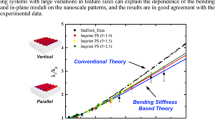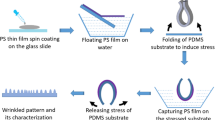Abstract
We describe the formation of nested wrinkles created by the thermal mismatch between a narrow-band thin film and a compliant substrate. When a film is described as “narrow-band”, it literally means that the film band width is much shorter than its length; more precisely, it means that the width is comparable with the wavelength of the wrinkles. A silicon mask was used during film sputtering to create narrow-band films on poly (dimethylsiloxane) substrate, thus creating regular boundaries to steer local stresses and control wrinkle morphology. Disordered nano-scale wrinkles were found nested within highly ordered micro-scale sinusoidal wrinkles. The formation of nested wrinkles was explained through the amplitude and wavelength saturation of nano-scale wrinkles. The disordered morphology of nano-scale wrinkles and the highly ordered morphology of micro-scale wrinkles were explained by using the boundary effect.
Similar content being viewed by others
References
Bowden N, Brittain S, Evans A G, et al. Spontaneous formation of ordered structures in thin films of metals supported on an elastomeric polymer. Nature, 1998, 393(6681): 146–149
Sun Y, Choi W M, Jiang H, et al. Controlled buckling of semiconductor nanoribbons for stretchable electronics. Nature Nanotechnology, 2006, 1(3): 201–207
Khang D, Jiang H, Huang Y, et al. A stretchable form of singlecrystal silicon for electronics on elastomeric substrates. Science, 2006, 311(5758): 208–212
Kim J B, Kim P, Pegard N C, et al. Wrinkles and deep folds as photonic structures in photovoltaics. Nature Photonics, 2012, 6(5): 327–332
Rahmawan Y, Moon M, Kim K, et al. Wrinkled, dual-scale structures of diamond-like carbon (DLC) for superhydrophobicity. Langmuir, 2010, 26(1): 484–491
Chan E P, Smith E J, Hayward R C, et al. Surface wrinkles for smart adhesion. Advanced Materials, 2008, 20(4): 711–716
Chung J Y, Nolte A J, Stafford C M. Surface wrinkling: A versatile platform for measuring thin-film properties. Advanced Materials, 2011, 23(3): 349–368
Efimenko K, Rackaitis M, Manias E, et al. Nested self-similar wrinkling patterns in skins. Nature Materials, 2005, 4(4): 293–297
Tokudome Y, Suzuki K, Kitanaga T, et al. Hierarchical nested wrinkles on silica-polymer hybrid films: Stimuli-responsive micro periodic surface architectures. Scientific Reports, 2012, 2: 683
Jiang H, Khang D, Fei H, et al. Finite width effect of thin-films buckling on compliant substrate: Experimental and theoretical studies. Journal of the Mechanics and Physics of Solids, 2008, 56 (8): 2585–2598
Yang S, Khare K, Lin P. Harnessing surface wrinkle patterns in soft matter. Advanced Functional Materials, 2010, 20(16): 2550–2564
Jiang H, Khang D, Song J, et al. Finite deformation mechanics in buckled thin films on compliant supports. Proceedings of the National Academy of Sciences of the United States of America, 2007, 104(40): 15607–15612
Stafford C M, Harrison C, Beers K L, et al. A buckling-based metrology for measuring the elastic moduli of polymeric thin films. Nature Materials, 2004, 3(8): 545–550
Harrison C, Stafford C M, Zhang W, et al. Sinusoidal phase grating created by a tunably buckled surface. Applied Physics Letters, 2004, 85(18): 4016–4018
Bowden N, HuckWT S, Paul K E, et al. The controlled formation of ordered, sinusoidal structures by plasma oxidation of an elastomeric polymer. Applied Physics Letters, 1999, 75(17): 2557–2559
Huck W T S, Bowden N, Onck P, et al. Ordering of Spontaneously formed buckles on planar surfaces. Langmuir, 2000, 16(7): 3497–3501
Chan E P, Crosby A J. Spontaneous formation of stable aligned wrinkling patterns. Soft Matter, 2006, 2(4): 324–328
Ding W, Yang Y, Zhao Y, et al. Well-defined orthogonal surface wrinkles directed by the wrinkled boundary. Soft Matter, 2013, 9 (14): 3720–3726
Polywka A, Jakob T, Stegers L, et al. Stretchable electronics: Facile preparation of high-performance elastically stretchable interconnects (Adv. Mater. 25/2015). Advanced Materials, 2015, 27(25): 3755–3759
Jiang H, Khang D, Fei H, et al. Finite width effect of thin-films buckling on compliant substrate: Experimental and theoretical studies. Journal of the Mechanics and Physics of Solids, 2008, 56 (8): 2585–2598
Acknowledgements
This work was supported by the Natural Science Foundation of Hubei Province of China (Grant No. 2015CFB443).
Author information
Authors and Affiliations
Corresponding author
Rights and permissions
About this article
Cite this article
Xu, H., Shi, T., Liao, G. et al. Controlling nested wrinkle morphology through the boundary effect on narrow-band thin films. Front. Mech. Eng. 14, 235–240 (2019). https://doi.org/10.1007/s11465-017-0458-6
Received:
Accepted:
Published:
Issue Date:
DOI: https://doi.org/10.1007/s11465-017-0458-6




